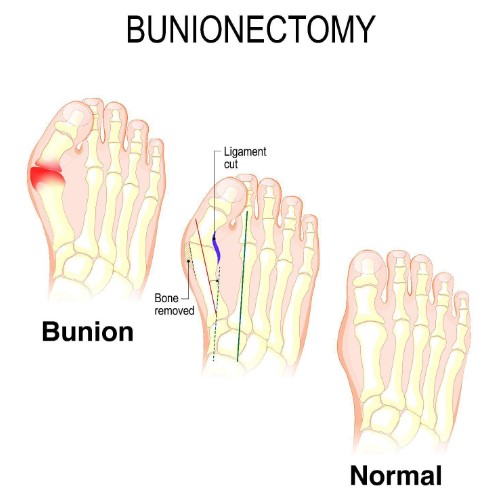
What is a bunion?
A bunion (also known as Hallux Valgus) is a deformity that forms at the base of the big toe. When the tip of the big toe constantly gets pulled towards the lesser toes, it creates a permanent bony bump.
This protrusion is often accompanied by pain and swelling, affecting one’s ability to walk or participate in sports. Additionally, as the base of the foot widens, you may also experience difficulty wearing footwear. It takes years for a bunion to fully form and for one to observe a clear intrusion of the toe inwards towards the other toes, making early identification paramount in minimising the damage a bunion entails.
This can be very uncomfortable, or even unsightly for some. Thankfully, there are treatments available for bunion removal.

Conservative measures
Relieving pressure on the foot helps with:
- Orthotics — Modified footwear, or orthotics, relieves pressure by supporting the foot and providing enough room in the toe box to compensate for the bunion.
- Weight Management — Excessive body weight puts unnecessary stress on your feet whenever you’re moving, and your big toe joint suffers the brunt of this pressure. Achieving optimal weight helps reduce pressure, preventing further formation and aggravation of the bunion, as well as increased inflammation and soreness.
- Medication — Medications such as Acetaminophen (Tylenol, others), ibuprofen (Advil, Motrin IB, others) or naproxen sodium (Aleve) can help alleviate pain caused by a bunion. Your orthopaedist may also recommend cortisone injections.
- Applying ice — Icing your bunion after you’ve been on your feet for too long, or if it becomes inflamed, can help relieve soreness and swelling.
Bunion surgery
If these measures do little to relieve your pain and ultimately hinder daily life, you can opt to have your bunion removed entirely. This can be done via conventional open surgery and minimally invasive surgery. Both procedures require a thorough assessment of the deformity and the structure of your feet before discerning what would provide an optimum outcome.
Conventional Open Surgery
Bunion surgery, also known as metatarsal osteotomy or bunionectomy, involves cutting the bones and repositioning them with internal plates, screws and/or wires. This helps straighten the big toe and reduce the deformity on the side of the foot.
Minimally Invasive Surgery
Minimally invasive (MIS) bunion surgery is an alternative to open surgery. This procedure involves a few “keyhole” (2mm-4mm) incisions over the affected areas before correcting deformities using miniature, specialised bone-cutting instruments that reshape the bone while minimising soft tissue injury. After which, the reshaped bone is stably fixed with small screws or wires.

Unlike conventional open surgery, minimally open surgery reduces the risk of infection and quickens recovery because of the precise nature of the smaller incisions. These incisions also reduce the risk of bleeding and guarantee minimal scarring.
Should you get bunion surgery?

Opting for surgery purely for cosmetic reasons is highly inadvisable as the foot is a highly complex biomechanical structure made of numerous bones, ligaments and tendons which bear a person’s weight. The disruption of this mechanic in any form could severely hinder the patient’s ability to move and potentially cause severe and irreparable damage over time.
However, if conservative measures for bunion formation are not proving fruitful, with deformities becoming more prominent and pain becoming increasingly severe, surgical intervention is recommended. You should consider bunion surgery if it is affecting your quality of life and causing great discomfort.
The next step would be deciding what type of bunion removal surgery to opt for. Based on your current condition and eligibility, your Orthopaedist will work with you in discerning what treatment would suit you best.
When to Call the Doctor

You should visit a doctor if the conservative measures mentioned earlier do little to alleviate pain or if your condition worsens. Please note, that the conservative measures serve to minimise pain, and the deformity cannot be fixed without surgical intervention.
You should also contact your doctor if you detect a noticeable bump or experience chronic pain and difficulty walking. Visit your orthopaedic surgeon for a proper diagnosis and treatment. Earlier detection increases your chances of opting for minimally invasive alternatives for less pain, faster recovery and better cosmetic outcomes.
References:
Aydogan, Umur. “Bunionette Deformity Correction | FootCareMD.” Footcare MD, https://www.footcaremd.org/conditions-treatments/toes/bunionette-deformity-correction. Accessed 10 October 2022.
“Bunions Can Occur at Any Age.” WebMD, 8 February 2001, https://www.webmd.com/skin-problems-and-treatments/news/20010208/bunions-can-occur-at-any-age. Accessed 10 October 2022.
“Bunions – Diagnosis and treatment.” Mayo Clinic, 6 November 2021, https://www.mayoclinic.org/diseases-conditions/bunions/diagnosis-treatment/drc-20354805. Accessed 10 October 2022.
“Bunions – Symptoms and causes.” Mayo Clinic, 6 November 2021, https://www.mayoclinic.org/diseases-conditions/bunions/symptoms-causes/syc-20354799. Accessed 10 October 2022.
“Bunion Surgery.” Johns Hopkins Medicine, https://www.hopkinsmedicine.org/health/treatment-tests-and-therapies/bunion-surgery. Accessed 10 October 2022.
Deland, Jonathan T. “Cosmetic Foot Surgery – Not Recommended by HSS, AFOAS or APMA.” HSS, 21 December 2018, https://www.hss.edu/conditions_cosmetic-foot-surgery-not-recommended.asp. Accessed 10 October 2022.
“The Early Stages of a Bunion.” Shore Podiatry, 29 March 2022, https://www.shorepodiatry.com/blog/item/734-the-early-stages-of-a-bunion.html. Accessed 10 October 2022.
Holland, Anne. “Minimally Invasive Bunion Surgery: Benefits and Recovery.” HSS, 20 January 2022, https://www.hss.edu/conditions_minimally-invasive-bunion-surgery.asp. Accessed 10 October 2022.
KONG, SW. “Bunions FAQs | Foot and Ankle | Doctor Articles.” Asia Medical Specialists, 8 October 2021, https://asiamedicalspecialists.hk/en/health-info/50/Bunions-FAQs. Accessed 10 October 2022.
Nagy, Brian. “Traditional vs Minimally Invasive Bunion Surgery: Know Which is Best.” Nagy Footcare, 7 August 2017, https://www.nagyfootcare.com/blog/traditional-vs-minimally-invasive-bunion-surgery-know-which-is-best/. Accessed 10 October 2022.
“Need Bunion Surgery? A Weight Bearing CT Scan Could Help You Decide.” CurveBeam, 3 May 2016, https://curvebeam.com/weight-bearing-ct/need-bunion-surgery-a-weight-bearing-ct-scan-could-help-you-decide/. Accessed 10 October 2022.
Viscovich, John B. “A Podiatrist’s 7 Best Ways to Prevent Bunions.” Westchester Health, 16 July 2020, https://www.westchesterhealth.com/blog/a-podiatrists-7-best-ways-to-prevent-bunions/. Accessed 10 October 2022.
